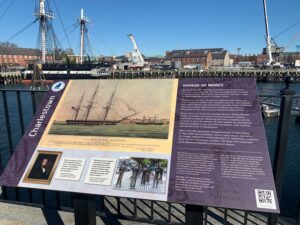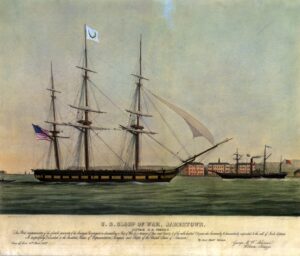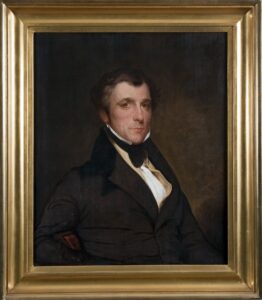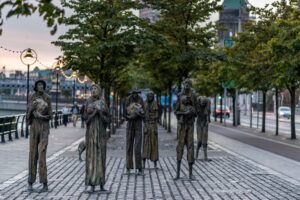Voyage of Mercy
in Charlestown
The USS Jamestown shown arriving in the harbor of Cork, Ireland. Stripped of its cannon, it brought more than 800 tons of food. “This privately-financed effort was the first ever American foreign aid mission,” writes historian Stephen Puleo in Voyage of Mercy. This lithograph was presented to Forbes as a token of thanks by the people of Cork.
Lithograph by George W. Atkinson, courtesy of the American Antiquarian Society
On March 28, 1847, the USS Jamestown set sail to Ireland from Pier 1, just opposite. The ship was loaded with hundreds of barrels of corn, flour, beans, pork and rice, donated mainly by New Englanders, many of modest means.
The previous summer, an airborne organism had wiped out most of Ireland’s potato crop. Potatoes were the main food for Irish tenant farmers who labored for absentee British landlords. With only a token response from the British government, thousands of Irish were dying of starvation and disease.
When reports of the famine reached Boston, Robert Bennet Forbes, a wealthy ship owner and humanitarian, quickly organized a response. Believing that only a warship had the capacity to carry the amount of food needed, he successfully lobbied Congress to use the USS Jamestown, then inactive and berthed here in Charlestown.
When the USS Jamestown dropped anchor in Cork harbor 21 days after leaving Boston, church bells rang in welcome. Its voyage inspired an unprecedented U.S. nationwide response. Over the next 16 months, another 149 ships from American ports delivered essential provisions to Ireland.
“The frigate [was] freighted with food for our people, and blessings be on the heads and hearts of those who sent and those who brought it. It is the noblest offering that nation ever made to nation…” From “Arrival of the Jamestown with Provisions,” The Cork Advertiser, April 15, 1847.
“Only a few steps out of one of the principal streets of Cork… I saw enough in five minutes, to horrify me—hovels crowded with the sick and dying…” Robert Bennet Forbes in The Voyage of the Jamestown on her Errand of Mercy, 1847.
“Famine” by Rowan Gillespie, unveiled in Dublin May 1997. The Great Hunger is seared into the memories of Irish people around the world. Lasting from 1846 to 1851, it killed an estimated 1.3 million Irish from starvation and attendant diseases. More than a million others had no option but to emigrate. In 1847 alone, 37,000 came to Boston, including 1,000 who arrived on a single day.
Image by AlBa344 via Wikimedia Commons
Sign Location

More …
Resources
- Forbes, Robert Bennet. The Voyage of the Jamestown on her Errand of Mercy. 1847.
- Laxton, Edward. The Famine Ships. Henry Holt, 1996.
- Puleo, Stephen. Voyage of Mercy: The Jamestown, the Irish Famine, and the Remarkable Story of America’s First Humanitarian Mission, St. Martin’s Press, 2020.
- Woodham-Smith, Cecil. The Great Hunger: Ireland 1845-1849. Harper and Row, 1962.
Acknowledgments
- We are deeply grateful to Stephen Puleo for his expertise and support of our work.
- Warm thanks to the Perkins School for the Blind and Thomasine Berg for creating the audio files.



